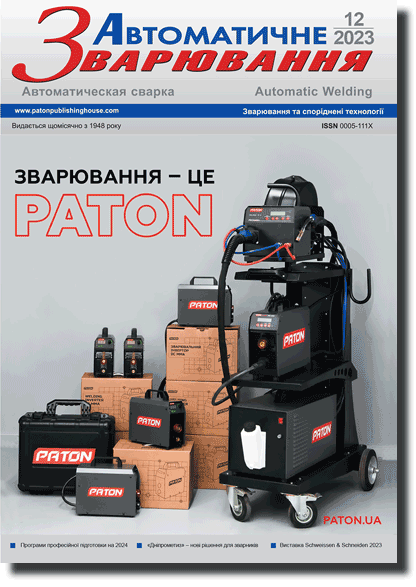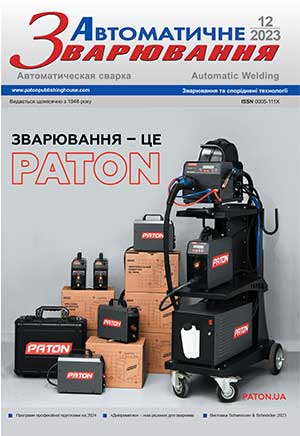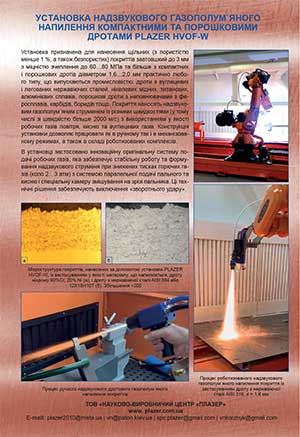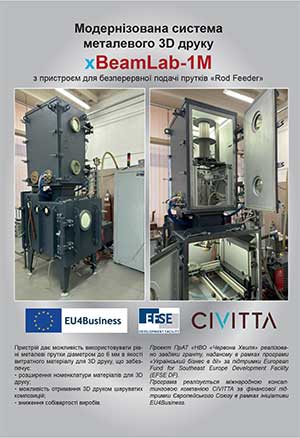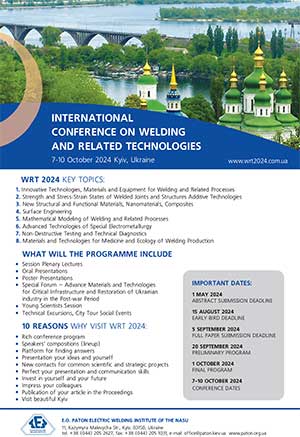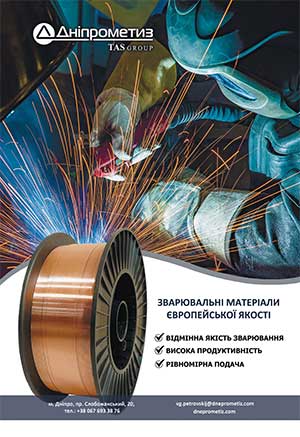| 2023 №12 (05) |
DOI of Article 10.37434/as2023.12.06 |
2023 №12 (07) |
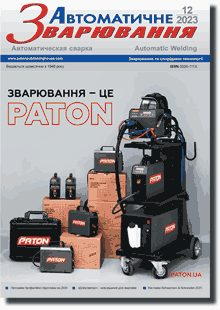
"Avtomatychne Zvaryuvannya" (Automatic Welding), #12, 2023, pp. 39-47
Electron beam welding of sheet inermetallic alloy with a controlled cooling rate
E.L. Vrzhyzhevskyi, N.V. Piskun, O.A. Velykoivanenko, I.I. Statkevych, T.G. Taranova
E.O. Paton Electric Welding Institute of the NAS of Ukraine. 11 Kazymyr Malevych Str., 03150, Kyiv, Ukraine. E-mail: office@paton.kiev.uaThe objective of this study is development and testing of elements of the technological process of electron beam welding (EBW) of intermetallic alloys of TiAl system, which allows performance of welding, preheating and subsequent local heat treatment of welded joints in one pass in one chamber, that enables preventing defects of the type of cold cracks, due to a controlled cooling rate. The work explains why EBW is exactly the most suitable process for welding titanium-based intermetallic alloys. A welding method is proposed and described in detail, which is performed in the gravity position at cantilever fastening of the samples in a special device, while heat treatment is conducted immediately after the completion of the welding process, ensuring an optimal cooling rate of the welded joint. It is found that cold cracking in the intermetallic welded joints is related to a low ductility of as-welded material. A mathematical model was developed for numerical prediction of the temperature field kinetics and stressed state calculation. The model was used as a basis to conduct a computational experiment and to determine the thermal conditions leading to cracking in EBW process. It is shown that the highest level of residual stresses is formed directly after completion of the welding process, is equal to 350 MPa and is observed in the weld center. In order to prevent cold cracks in welded joints of titanium aluminide samples, a technological measure was proposed, which combines EBW of Ti–44Al–5Nb–3Cr–1.5Zr (at. %) intermetallic with preheating and postweld local heat treatment (LHT). It was numerically shown and experimentally confirmed that application of a distributed source of sample preheating before welding creates favorable conditions during welding and at further cooling, namely lowering the tensile stresses, namely lowering the magnitude of tensile stresses. The way the process is implemented and its influence on the stressed state and structure of the produced joints are described in detail. The work gives the modes of EBW of sheet intermetallic alloy with a controlled cooling rate and results of structural and mechanical studies of the welded joints, produced by the proposed technology. Ref. 15, Tabl. 3, Fig. 11.
Keywords: electron beam welding, TiAl system intermetallics, sheet plates, controlled cooling rate, stressed state, «gravity» welding, local heat treatment.
Received: 10.10.2023
References
1. Nochovnaya, N.A., Panin, P.V. (2014) Analysis of residual macrostresses in welded joints of different class titanium alloys. Moscow, VIAM [in Russian]. https://doi.org/10.18577/2307-6046-2014-0-5-2-22. Iliin, A.A., Kalachev, B.A., Polkin, I.S. (2009) Titanium alloys - composition, structure, properties. Moscow, VILS-MATI [in Russian].
3. Makhnenko, V.I., Poznyakov, V.D., Velikoivanenko, E.A. et al. (2009) Risk of cold crack formation in welding of structural high-strength steels. Zbirnyk Nauk. Prats NUK, 3, 5-12 [in Russian].
4. Mandelberg, S.L., Gordonny, V.G. (1961) One-sided two-layer argon-arc welding of thin sheet alloyed steel. Avtomatich. Svarka, 9, 68-73 [in Russian].
5. Chen Guoqing, Zhang Binggang, Liu Wei, Feng Jicai. (2011) Crack formation and control upon the electron beam welding of TiAl-based alloys. J. Intermetallics, 19, 1857-1863. https://doi.org/10.1016/j.intermet.2011.07.017
6. Zhuk, G.V., Trigub, N.P., Zamkov, V.N. (2003) Producing of titanium gamma-aluminide ingots using EB'HM method. Special Electrometallurgy, 1, 19-21 [in Russian].
7. Nesterenkov, V.M., Bondarev, A.A. (2014) Electron beam welding of large-size thick-wall structures of magnesium alloys. The Paton Welding J., 2, 37-41. https://doi.org/10.15407/tpwj2014.02.05
8. Olshanskaya, T.V., Fedoseeva, E.M. (2019) Selection of main criteria of thermal cycle for methods of prediction of weld structure in electron beam welding. Vestnik Permskogo NPU, Mashinostroenie, Materialovedenie, 21(2), 73-81 [in Russian]. https://doi.org/10.15593/2224-9877/2019.2.09
9. Piskun, N.V., Vrzhizhevskyi, E.L., Kostin, V.A. et al. (2022) Influence of time of existence of molten pool in electron beam processes on the level of evaporation of elements with a high vapor tension. The Paton Welding J., 1, 26-32. https://doi.org/10.37434/tpwj2022.01.06
10. Velikoivanenko, E.A., Milenin, A.S, Rozynka, G.F. et al. (2019) Forecasting of inclination of welded joints of titanium γ-aluminide based alloy towards cold cracking under electron beam welding. Tekhnologicheskie Sistemy, 3, 59-66 [in Russian]. dx.doi.org/10.29010/88.9
11. Zamkov, V.N., Velikoivanenko, E.A., Sabokar, V.K. et al. (2001) Selection of temperature of preheating of γ-titanium aluminide in electron beam welding. The Paton Welding J., 11, 17-20.
12. Lobanov, L.M., Asnis, A.E., Piskun, N.V. et al. (2019) Investigation of stress-strain state of welded joints of the system TiAl intermetallics. The Paton Welding J., 11, 8-11. https://doi.org/10.15407/tpwj2019.11.02
13. Imaev, V.M., Imaev, R.M., Gaisin, R.A. et al. (2017) Heat-resistant intermetallic alloys and composites based on titanium: Microstructure, mechanical properties and possible application. Materials Physics and Mechanics, 33, 80-96.
14. Imaev, V.M., Imaev, R.M., Khismatullin, T.G. (2008) Mechanical properties of cast intermetallic alloy Ti-43Al-7(Nb, Mo) - 0,2 V (at. %) after heat treatment. Fizika Metallov i Metallovedenie, 105(5), 516-522 [in Russian]. https://doi.org/10.1134/S0031918X08050098
15. Lobanov, L.M., Asnis, A.E., Piskun, N.V. et al. (2020) Influence of local heat treatment on mechanical properties of welded joints of TiAl system intermetallics produced by electron beam welding method. Avtomat. Zvaryuvannya, 9, 36-41 [in Ukrainian]. https://doi.org/10.37434/as2020.09.04
Advertising in this issue:
The cost of subscription/purchase order journals or individual articles
| Journal/Currency | Annual Set | 1 issue printed |
1 issue |
one article |
| TPWJ/USD | 384 $ | 32 $ | 26 $ | 13 $ |
| TPWJ/EUR | 348 € | 29 € | 24 € | 12 € |
| TPWJ/UAH | 7200 UAH | 600 UAH | 600 UAH | 280 UAH |
| AS/UAH | 1800 UAH | 300 UAH | 300 UAH | 150 UAH |
| AS/USD | 192 $ | 32 $ | 26 $ | 13 $ |
| AS/EUR | 180 € | 30 € | 25 € | 12 € |
| SEM/UAH | 1200 UAH | 300 UAH | 300 UAH | 150 UAH |
| SEM/USD | 128 $ | 32 $ | 26 $ | 13 $ |
| SEM/EUR | 120 € | 30 € | 25 € | 12 € |
| TDNK/UAH | 1200 UAH | 300 UAH | 300 UAH | 150 UAH |
| TDNK/USD | 128 $ | 32 $ | 26 $ | 13 $ |
| TDNK/EUR | 120 € | 30 € | 25 € | 15 € |
AS = «Automatic Welding» - 6 issues per year;
TPWJ = «PATON WELDING JOURNAL» - 12 issues per year;
SEM = «Electrometallurgy Today» - 4 issues per year;
TDNK = «Technical Diagnostics and Non-Destructive Testing» - 4 issues per year.





